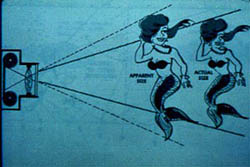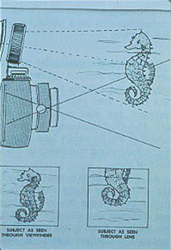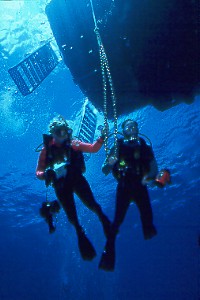|
Sometimes when I am
writing these little photo hint articles, I sit frozen,
staring at the screen....because, even after 40 years of doing
photography, there are so many things I can say that it
is sometimes hard to decide what to talk about next....I am
still learning new things myself, and photographers are
getting overwhelmed now with new technologies.
These
articles are not intended to be an extensive photo course, as
I don't believe there is that much room on the web for
that! I will cover some of the major problems people
have, and also gear these hints to the most common questions I
receive. No matter what equipment you do use, however, there
are some standard rules that still apply.
Most of
you who get into underwater photography will be using
viewfinder cameras. That includes the Nikonos systems. What
that means is, when you look through the viewfinder, your
subject appears to be in focus. The viewfinder is not
connected to the lens, and the lens may not be adjusted in
focus. Some of you who have the SLR (single lens reflex)
cameras for land photography, find this disconcerting,
because you may keep forgetting to manually focus the lens
with each shot when you are underwater.
Remember to manually
adjust the focus on the lens for every shot, or you will
have out of focus photographs. (Of course, when you do make
that mistake, you can always tell everyone
you are going for that "soft focus" look and used a diffusion
filter!!) Speaking of focus, and this is very important, especially
when you use a strobe - Underwater, always
focus at the distance your subject appears to be (the
apparent distance).

Apparent Size
Drawing
Focus on the Apparent distance, not the
actual distance of your subject
Remember one of the things you learned in
your dive class - that an object that appears to be 3' away is
really 4' away. Ignore the fact the subject is really
further away, the camera sees just as you do!
The other problem with
the viewfinder camera is something called "parallax error".
Note the lovely photo below....

Parallax Drawing
At close distances, move the camera up to
compensate for parallax error
When
you get close to a subject (less than 3'), and you look
through the viewfinder to compose your picture, you
think that what you see in the viewfinder is what the lens
sees! AH HAA! Fooled you again! The viewfinder, up by
your eye sees one thing. The lens, down by your nose, sees
another! The result is you will cut of some part of the
subject, usually heads or fins. This applies to fish as well
as mermaids. Of course, if you do see mermaids
underwater, you are visiting the wrong website, and probably
have been in www.baddrugs.com....
A helpful hint for you
that seems to work well for me is - I put a large dot on the
back of the camera, directly in line with the lens. I compose
my picture through the viewfinder, then before I push the
shutter, lift the camera up so the dot is now in front
of my eye, and snap the picture. Works like a charm. But, you
must remember to lift the darn camera for close subjects. Some
lenses, like the 35mm, may only focus down to 2.75', and
the 15 mm (at f22) can focus down to inches, so when you are
working close, remember the viewfinder is for aiming
only. If you are using a Nikonos viewfinder, they have
parallax compensation marks in the viewfinder - make
sure your subject is composed below those marks.
If there are any
subjects you would like me to write about or problems you are
having (with photography that is) that need addressing, send
me your ideas/suggestions, and who knows? Maybe I can answer
them...or maybe not. Dive safely, and good
shooting!
|



